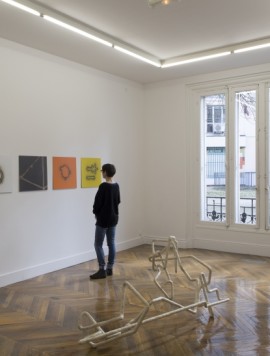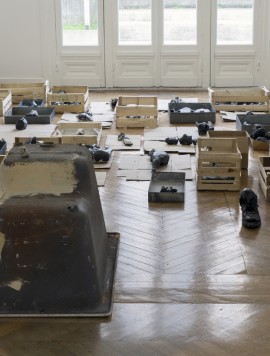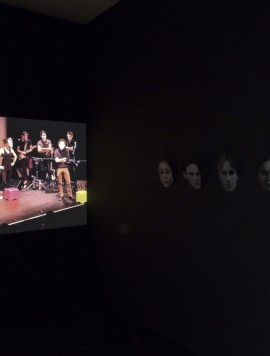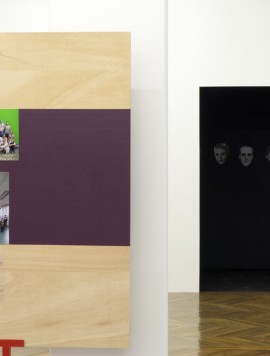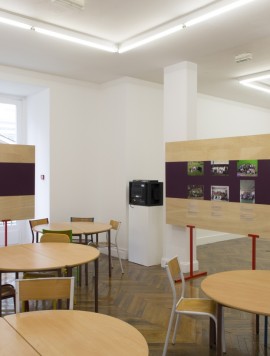Goodbye Sadness, Desire, Lassitude, Appetite, Pleasure
“Goodbye Sadness, Desire, Lassitude, Appetite, Pleasure” is the follow-up to the exhibition whose near-identical title began with “Hello”, the two bookending a season devoted to “forms of affects”. The first of them brought together individual authorial stances in works giving access to a single subject through a (sometimes radically solipsistic) first-person discourse. In this new exhibition, by contrast, the artist involves other people, raising the issue of defining oneself in relation to others in terms of common and even provisionally shared affects. The exhibition testifies to different styles of address, to the ways an artist transmits and receives, acts and reacts, with all the doubts, negotiations and renunciations – as well as the accelerations and shifts – associated with any collective exploration. Founded on exchange, their artistic processes must necessarily be explained, but many of the exchanges are silent, hinging on gesture and subconscious languages which, while sometimes generating incomprehension, often ultimately turn out to be productive. This exhibition is devoted to artists who, once they open up their practice to others, control and let go at the same time; and for whom the artwork is the outcome of a process of negotiation, with all the indeterminacy this implies for better and for worse.
In a talk given during the first exhibition Maxime Cervulle, author of Dans le blanc des yeux, diversité, racisme et médias 1 (“In The Whites of Their Eyes: Diversity, Racism and The Media”, 2013) spoke of affect as distinct from emotion: “Affect can be defined as a force circulating in the social domain, whose contours it reshapes dynamically. Emotion, on the contrary, is situated at the individual level; it tends to shut the body in on itself and define its borders, thus producing a powerful feeling of individuation, of a singular first-person experience. This distinction between affect and emotion does not mean, however, that one is exclusively social and the other exclusively to do with the psyche. Both affect and emotion are marked by social dynamics and involve a pronounced emphasis on the relational. The question of the connection between the two is interesting in that it allows us to rethink subjectivation, that is to say the process of construction of the subject. It raises in different terms the issue of the forces (or affects) that constrain the subject.” Cervulle outlined the notion of the subject advanced in the 1990s by “affect studies” in North America 2: “At the core of Massumi’s theory is the idea that social forces find in us – in our bodies and our subjectivity – the means of their own intensification. In other words he is talking about the expression of a social historicity in our actual flesh.” This approach enables a view of the subject as complex, at once active and passive and intimately related to society: an unstable, no longer unified subject locked into either a form of exteriority itself subject to an implacable social determinism, or an absolute, inaccessible form of interiority.
Applied to the field of art, this approach enables a linking of affect to a conceptual dimension and so reveals its positive role in creative processes, on an equal footing with a statement of intent. This recognition of how closely affect connects the artist with his work points up the equivocality of this relationship – part urge to control, part capacity to let go – while at the same time dismissing two canonical, univocal conceptions of what the artist does: on the one hand a determinism that subjects the artwork to the social identity of its creator, and on the other an expressionism that presupposes a direct emotional link with the work, a putting of one’s faith in a free, liberating creativity.
In the exhibition it is above all in the artist’s relations with others that the active role of affect in his or her work becomes perceptible. The recurring motif that makes this relationship visible is the body – fragmented, isolated or in groups – and above all the face: the smiling faces of students when a complex string shape materialises in their hands (murphy); faces shut in on themselves like solitary, innocuous recumbant figures (Swaim); the faces of teenagers who have made their own T-shirts for a class photo – for presentation of the self within a group (Åbäke); overlaid faces, one made of paper with eye holes, the other speaking in its own voice from behind the mask of a member of the artist’s personal pantheon, mixing its words with those of the other it is embodying (Gonzàlez); faces of blind children groping their way through the world, firstly inside the protective compound of the school they finally succeed in exiting (van der Keuken). And in turn these eyes look at us. As access to a form of interiority, they call for our empathy in a mute confrontation.
There are other eyes too, among them those of the photographer, the filmmaker and the theatre director. Many of these images are the work of a third party: students photographing their classes in testimony to a horizontal learning process initiated by their teacher (murphy); former workers – including the artist’s parents – photographing their own tools, bought after the factory they worked in went bankrupt (Skála); a professional photographer bowing to the rules of the “class photo” genre (Åbäke); a theatre’s technical team recording and editing live (Gonzàlez); a locksmith designing a straight-line metal structure to be covered by the artist with a fragile coating which perfectly preserves the piece’s original line (Momein). These images and forms, then, are not just evidence: they reveal the photographer’s degree of detachment as he takes the photograph, the artist’s involvement in the work. Here the intensity of a relationship is made visible.
In addition to these bodies and exchanges as such, we come to perceive their collective settings: the school (murphy, Åbäke, van der Keuken), the workshop and the factory (Momein, Skála), a theatre stage (Gonzàlez), lectures and their audiences, groups formed for a particular occasion (Åbäke), the art centre and a physical merging of its two essential functions as exhibition space and workshop (Buchanan and Müller), and last of all a floor strewn with shattered sculptures and fragmented bodies evocative of that ultimate common place, a cemetery (Swaim).
The people portrayed, the artists and their third parties, “we” who are looking at them and the institutions they are involved with are all components of works whose social aspects underscore their inherent affective content. This contact between collective structures and the interpersonal side of the works helps define the relative places of the artists, their intermediaries and those who observe them. Keuken had this to say about the part a form of empathy plays as a process for exiting the self and as a creative driving force: “These blind people do not exist solely in groups; they exist as individuals too, like each one of us. There’s a question I never stop asking myself: how would I be if I were in so-and-so or so-and-so’s situation? I see this question as a very powerful motor in a lot of artworks.” 3
Émilie Renard
Translated by John Tittensor
1. Maxime Cervulle, Dans le blanc des yeux, diversité, racisme et médias
(Paris: Editions Amsterdam, 2013).
2. Notably with the simultaneous publication in 1995 of the essays “The Autonomy of Affect” by Brian Massumi and “Shame in the Cybernetic Fold” by Eve Sedgwick and Adam Frank.
3. Serge Daney and Jean-Paul Fargier, “Entretien avec Johan van der Keuken”, in Cahiers du cinéma, no. 289, 1978. Source: www.sabzian.be/article/johan-van-der-keuken-entretien-dans-cahiers-du-cinema, consulted February 2014.
around the exhibition
-
08/03/2014
From 6 pm to 7 pm
Reading of excerpts from Jirí Skála’s One Family of Objects. Part of Eastern Trail #16.
—
Free, advance booking required: resa@parcours-est.com / www.parcours-est.com
-
22/03/2014
From 3:30 pm to 5 pm
Guided tour of the exhibition and the residence studio with artist Nicolas Momein and La Galerie director Émilie Renard.
Part of Open Your Art: Contemporary Art in North-Eastern Paris, organised by the Seine- Saint-Denis Tourist Committee.—
6 €. Bookings and information: www.tourisme93.com/art -
05/04/2014
From 3:30 pm to 5 pm
Round table “When seeing is feeling and, thus, knowing”: teaching methods common to the art field and experimental education Thibault Brébant (artist-educator at La Galerie), Pascale Gadon (founder of the Pac’Bô rural art school project), Yvette Servin (Freinet Method teacher in public schools in Paris, 1974–1978), a teacher from the Vitruve public school, Paris.

